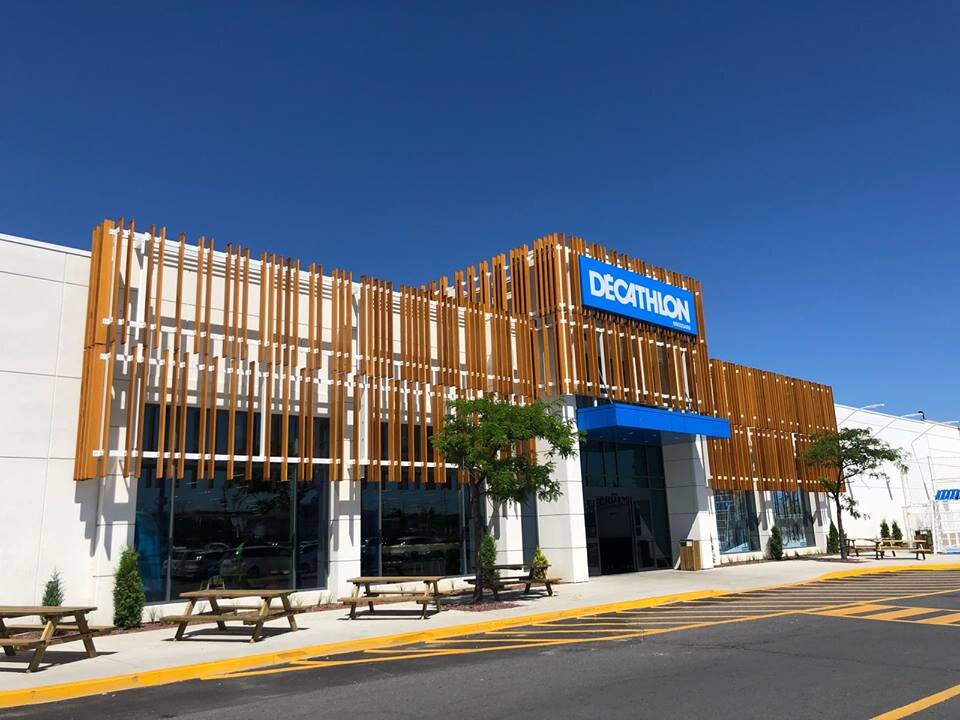Canadian Retail Expert Discusses Changes to the Industry
/PHOTO: GEORGE PIMENTEL
By Mario Toneguzzi
Eileen Halpin-Tarrant has a career in retail that dates back to June 5, 1984 and over those years she’s experienced massive changes in the industry.
EILEEN HALPIN-TARRANT
“It’s obviously a completely different world considering we didn’t have the connectivity and accessibility to the degree that we do now. Especially when considering online shopping and Amazon. The landscape has drastically changed in how retailers view shopping centres and retail space - and ultimately how much space they need,” said Halpin-Tarrant, who is President – Client Services, Broker of Record (Ontario) / Managing Broker (British Columbia) with Oberfeld Snowcap Realty, Brokerage.
“Bricks and mortar retail has to be much more ‘promotional’ today to get consumers’ attention. We are seeing trends that many retailers are perpetually on sale. This tactic is understandable given that consumers have instant access to price comparisons and convenience via online shopping. You’ve got to really be focused on continuously implementing sales promotions to gain and hold traction,” she said.
PHOTO: MATT & NAT
“It’s a different experience for the customer today. The retail environment is much more “experiential”. Consumers typically still want to touch and feel the products before buying them, however getting them in the doors is now one of the core challenges to the industry. Before online shopping took off, it seemed like you would just open your doors and in came the customers. Now, you really have to speak to them at every level – and that means retailers that are emphasizing omni-channel marketing are reaping the benefits.”
“This extends to the landlords now as well. Certainly, malls and shopping centres are increasingly positioned as their own brands with distinct omni-channel marketing schemes. It’s not enough today to simply be a well-positioned mall with a strong lineup of retailers. Major landlords have marketing teams (that are winning awards for their work) dedicated to connecting to consumers and occupying space in their minds as the best places to live, shop, work, and play. Remember Yorkdale’s seemingly viral “Fashion Santa?”, or how about celebrity meet-and-greets at major malls? Today, retailers increasingly rely on landlords to drive traffic and develop centres that remain competitive, especially as shopping options for consumers continue to expand.”
“At the end of the day, the customer is really the one running the show. If you don’t speak to them and you don’t give them what they’re looking for, then they’re on to the next one – whether that’s the next mall, the urban street-front locations, or online shopping mediums. The loyalty factor is gone. There’s not as much attachment to brands as there once was, that’s for sure.”
Halpin-Tarrant’s first position in the retail real estate industry was with Bramalea Limited, in the shopping centre division. She started in an entry level position and progressed to the role of Leasing Manager where she focused on the leasing of various shopping centres in their portfolio at the time, including Yorkdale Shopping Centre, Scarborough Town Centre, as well as the Halifax Shopping Centre redevelopment, to name a few.
Then in 1993, she went to work at Burnac Leaseholds as Director of Leasing responsible for various properties throughout Atlantic Canada and Ontario. After spending five years there, she went to SMARTCentres where she was Vice President, Leasing for six years.
Halpin-Tarrant has now been with Oberfeld Snowcap for the past 15 years.
Despite the massive evolution in the retail industry in recent years with the explosion of online shopping, bricks and mortar remain a key part of a retailer’s success, she says.
PHOTO: SHOPPERS DRUG MART VIA FACEBOOK
“It’s changed. Typical footprints for retailers at 20,000 square feet for instance now may only be 10,000 square feet. Retailers are required to do more with less space to remain profitable. The number of locations has changed too. Certain retailers potentially don’t need as many locations. Many brands now take the ‘storefront-as-showroom approach.” said Halpin-Tarrant.
“If landlords are open to negotiating – and I find they are more than ever right now – retailers can find favourable deals with major landlords when they position themselves as first-to-market concepts that need incubation. You typically see this with online concepts who want to go to bricks and mortar, and that’s what we need more of to keep the shopping centres unique and on trend. We need landlords to continue to be creative with options for these brands.”
Halpin-Tarrant says that landlords are also looking for alternative uses, and not just fashion, as much as it is still a dominant retailer in shopping centres. Entertainment, food and beverage, and unique offerings are trending as more alternative attractions in shopping centres to attract more people and increase their dwell time which is ideally then captured in the gross sales volumes of the shopping centres.
PHOTO: THE TEN SPOT VIA FACEBOOK
“Anything that’s unique, that’s experiential, that’s really where you’re going to see the trends in the future,” added Halpin-Tarrant.
She explained how shopping centres have evolved over the years simply because they had to. “They can’t stay static in this ever-changing world where online shopping has become more popular. They’ve evolved to offer more of a community place to gather versus just being a place to come and shop. We are seeing residential being added to shopping centres also in order to build traffic and add to that experience of shopping, dining, being entertained all within steps to your residence.”
“At the end of the day, we’re social creatures. We still want to get out there and be part of the experience. The landlords that design their centres towards that concept are the ones that are going to be successful,” she said.
Halpin-Tarrant has been on both sides of the retail real estate transaction - representing landlords and tenants.
PHOTO: DECATHLON VIA FACEBOOK
What are the major differences between the two?
“It’s interesting because when I first started working on the brokerage side, and specifically the tenant advisory side, I felt like I wasn’t in control. When you’re on the landlord side, you’re the one making a decision on the merchandising mix of your centre, and you know that whatever happens that it was your call at the end of the day,” she said. “But on the tenant side, it’s definitely a different experience. Just after I joined Oberfeld Snowcap, I said to myself ‘I don’t know if I like this - I can’t make decisions for my client’. In reality, you’re the one that’s advising and bringing the parties together and by doing that, that’s how the decisions are made.”
“So it’s less about making decisions, and more about offering solutions. We’re finding the middle ground between both parties. At Oberfeld Snowcap, we’re facilitating the deal – driving both parties towards an end result with the right deal that works for everyone involved.”
PHOTO: CARREFOUR DE L’ESTRIE VIA FACEBOOK
Halpin-Tarrant said the appeal for her in working in this industry is the realization that she, and those who work in the field, are instrumental in helping retailers grow their brand across the country.
“I’ve always had the mindset when providing advice to our clients as if it was my own business. The recommendations that I put forward are always based on the question – ‘what would I do here?’. To me, when you see your clients go from store one to store 100, that’s exciting. That has been a core motivation which has translated into a love for what I do,” she said.
“Today, the foundations of that motivation are still there, but the goals have evolved for me. I have always been proud and focused on building a strong team at Oberfeld Snowcap. We have some of the best people in the industry who have a passion for what they do and for the success of our clients. I’m now more focused than ever on passing my experience on to others. At this point in my career, that feels right to me - sharing my knowledge, and witnessing those around me grow. That inspires me!”
*Oberfeld Snowcap is a valued partner of Retail Insider. To work with Retail Insider, email: craig@retail-insider.com
Mario Toneguzzi, based in Calgary has 37 years of experience as a daily newspaper writer, columnist and editor. He worked for 35 years at the Calgary Herald covering sports, crime, politics, health, city and breaking news, and business. For 12 years as a business writer, his main beats were commercial and residential real estate, retail, small business and general economic news. He nows works on his own as a freelance writer and consultant in communications and media relations/training. Email: mdtoneguzzi@gmail.com.










![L.L.Bean Continues Canadian Expansion with 1st Toronto Store [Photos]](https://images.squarespace-cdn.com/content/v1/529fc0c0e4b088b079c3fb6d/1603908990197-KDT3UNTEHFBFJF5FJ36N/L.L.Bean_Don_Mills_8.jpg)





![Retail-insider-NRIG-banner-300-x-300-V01-3[2].jpg](https://images.squarespace-cdn.com/content/v1/529fc0c0e4b088b079c3fb6d/1593476525034-QRWBY8JUPUYFUKJD2X9Z/Retail-insider-NRIG-banner-300-x-300-V01-3%5B2%5D.jpg)
![Retail-insider-NRIG-banner-300-x-300-V01-2[2].jpg](https://images.squarespace-cdn.com/content/v1/529fc0c0e4b088b079c3fb6d/1593476491497-W6OZKVGCJATXESC9EZ0O/Retail-insider-NRIG-banner-300-x-300-V01-2%5B2%5D.jpg)
![Retail-insider-NRIG-banner-300-x-300-V01-4[2].jpg](https://images.squarespace-cdn.com/content/v1/529fc0c0e4b088b079c3fb6d/1593476508900-TJG5SNQ294YNOCK6X8OW/Retail-insider-NRIG-banner-300-x-300-V01-4%5B2%5D.jpg)